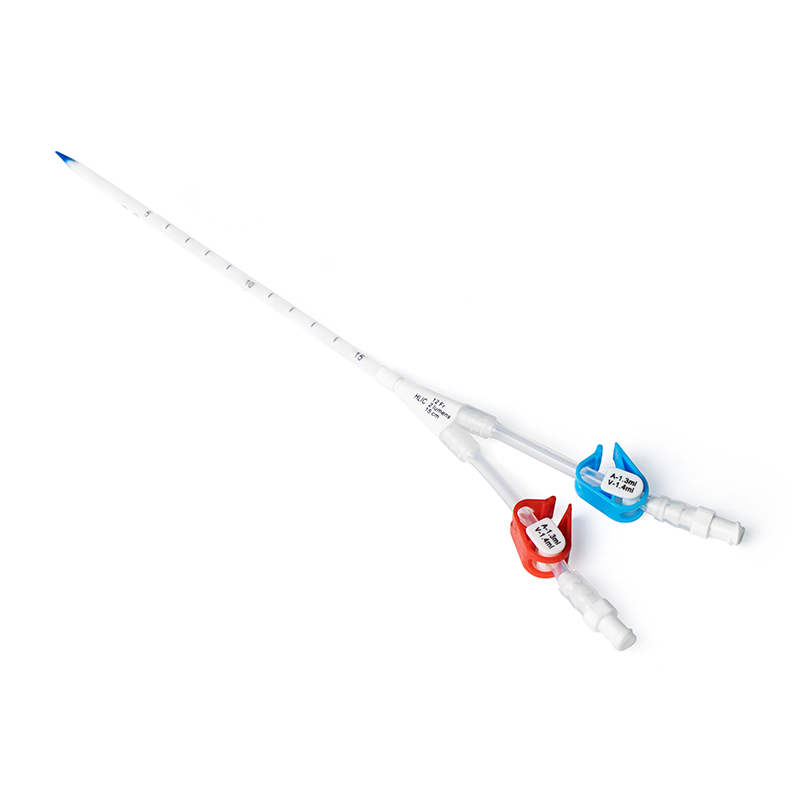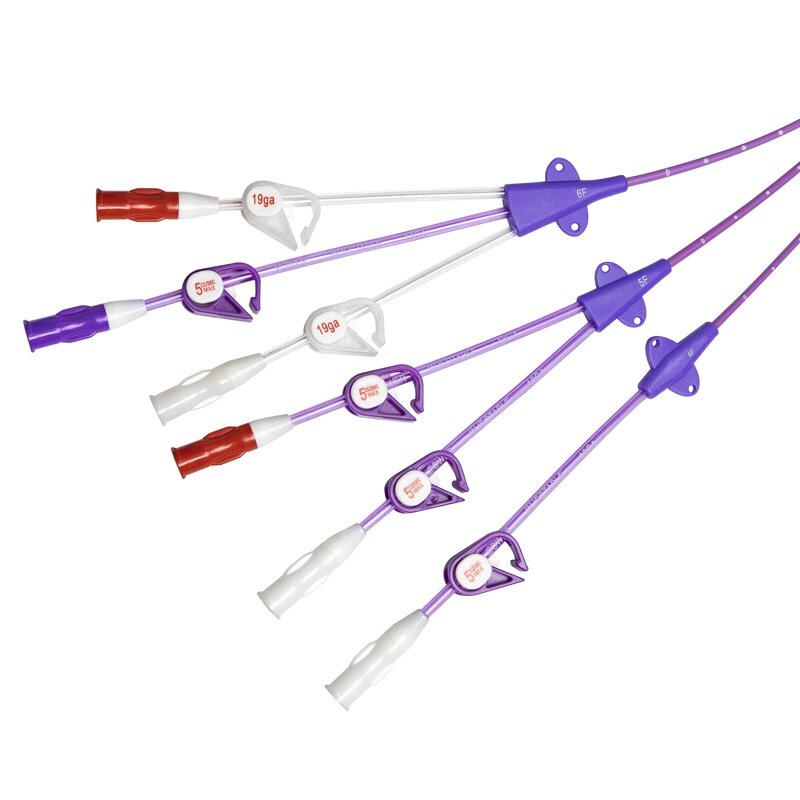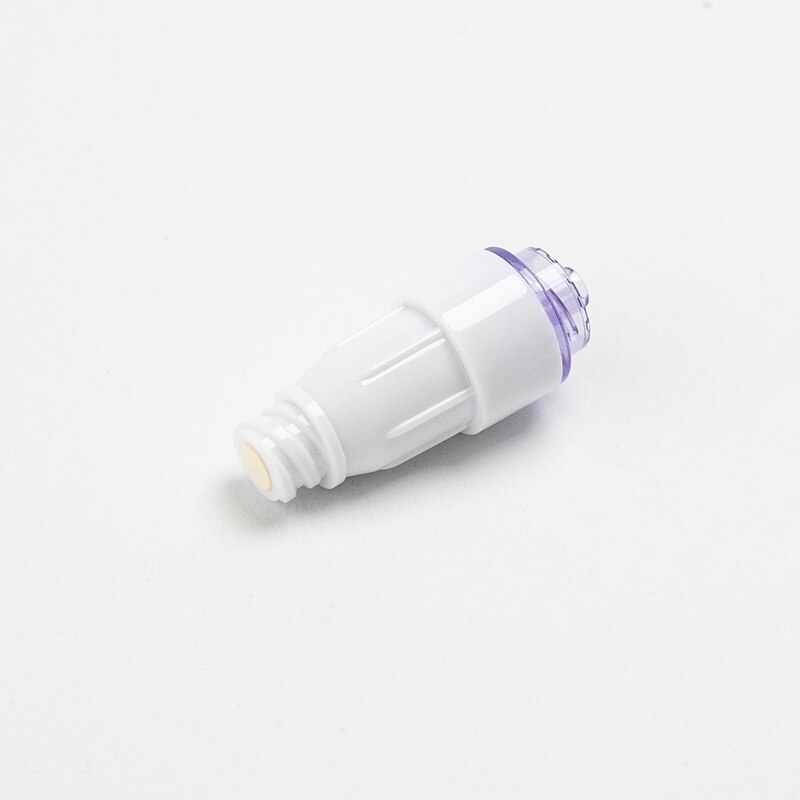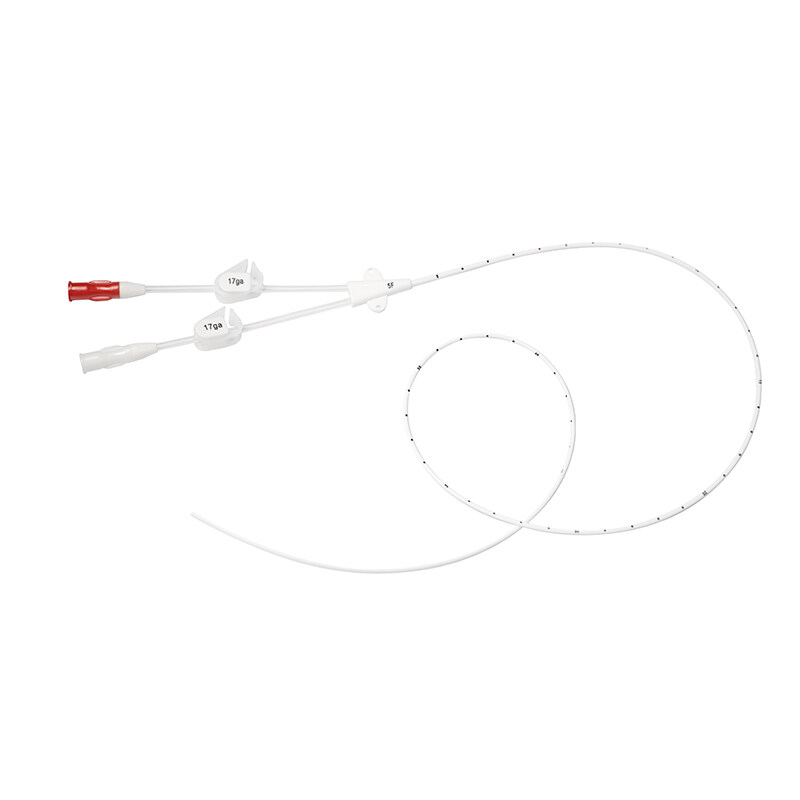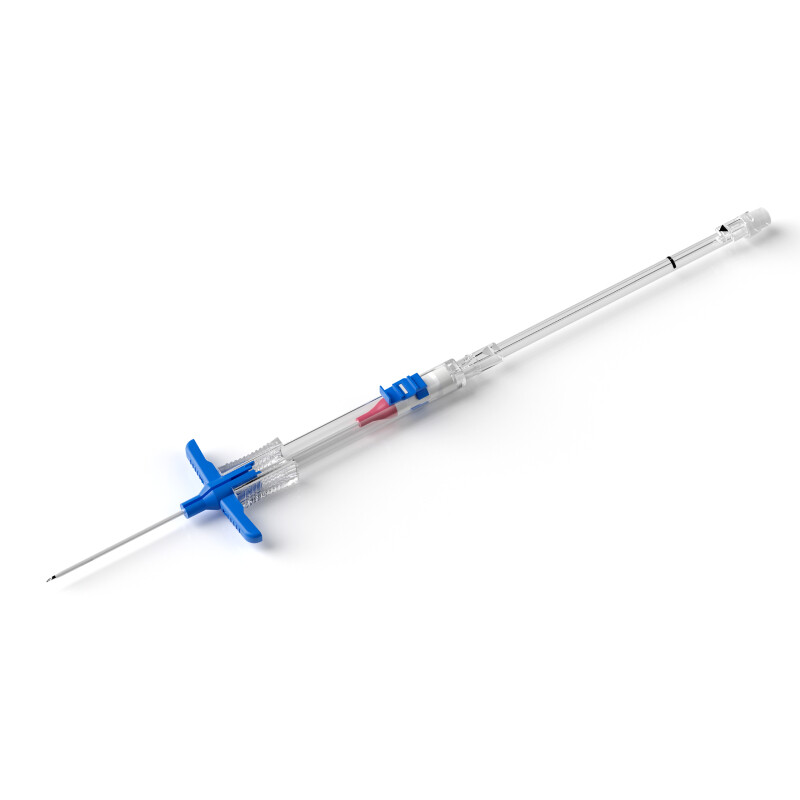Papers sharing from Faculty of Medicine, Yangtze University and Cancer Center of Hubei Provincial People's Hospital
Mini-midline [1-2] is an external intravenous infusion device between short catheters (SC) (length <6 cm) and midline catheters (MC) (length 15 to 30 cm), usually placed in the shallow vein of the forearm with conventional puncture techniques, or placed in the deep vein of the middle of the upper arm with ultrasound guidance technique, the tip should not exceed the armpit, and is 6 to 15 cm long. The sizes of Mini Midline range from 3F to 5 F, generally indwelling time from 1 to 4 weeks [3] . The flow rate of the catheter is determined by the catheter size and length, the most common in China is 8cm (20 G or 22 G) and 10 cm (18 G) 2 types, the catheter is made of polyurethane material. Scholars such us Fabiani [4] said that the economic cost of mini midline catheters is 1/6 times that of Midline catheters.However due to the large gap between domestic and foreign countries in terms of catheterization and maintenance costs, meantime, there is a lack of high-quality research in China to confirm the validity and credibility of this conclusion, and further research and exploration are needed in the future. Mini midline catheters have certain advantages over other catheters in terms of temporality (catheterization time and indwelling time), economy (catheterization costs and maintenance costs), and practical safety (complications) of integrated intravenous infusion devices. The research and application of mini midline in China is still in the initial stage of exploration, there are still many deficiencies in the application of mini midline, there are differences in the naming and usage of 6 to 15 cm intravenous catheters [ 5 ], the author will use the mini midline [6] as the name and will review the current status of mini midline as well as the clinical application effects, providing a reference for clinical application and further research.
2.Clinical applicaion status of Mini midline
2.1 Application of Mini midline in critically illness patients
Mini midline are widely applied in emergency and intensive care units. Especially for the veins of critically illness patients with the following venous characteristics: Superficial veins that are difficult to touch and/or cannot be directly visualized [21-23] and need a short-term venous treatment in the later stage, but the patients does not require central venous access while it is urgent to establish an effective and reliable venous access [16,24-25] .For critically illness patients who has poor blood vessel conditions, the failure rate of intravenous catheterization is 25 [7] . The urgent placement of reliable venous pathway is time consuming and challenging, and patients with catheter-related complications can aggravate the economic burden, endanger patient's life, even lead to death [26-27] as a result. At present, it is a hot issue in clinical research to choose a catheter with short indwelling time and high success rate of one-time catheterization and ideal indwelling time for critically illness patients .
Studies have shown that the entire placement process of completing a mini midline takes an average of 9.5 minutes and the success rate of catheterization is 1.57 times per catheter [2], which can meet the need to establish an effective venous pathway in an emergency and also reduce the pressure to establish intravenous access for clinical caregivers. A series of studies reported that the complication rate of Mini midline is significantly higher than that of central venous catheters (CVC), and the incidence of Mini midline -related thrombosis and catheter-related bloodstream infection (CRBSI) is 1.7% [28] and 0.6% [29] respectively, significantly lower than that of central venous catheters [30]. Studies have shown that 24.7% of central venous catheters are estimated to develop into catheter colonization and 5.2% to catheter-associated bloodstream infections (the occurrence of local catheter-associated infections results in an additional cost of approximately US$ 400, while the additional cost of catheter-associated bloodstream infections is as high as US$ 6 005 to US$ 9 738 [ 31 ]), and catheter-associated bloodstream infections can prolong hospital stays, increase financial burden, and even endanger the lives of patients [25]. Mini midline catheterization time is short, and the incidence of catheter-associated bloodstream infection is significantly lower than that of central venous catheter, which effectively avoids the risk of surgery and complications caused by unnecessary central venous catheterization [16], and reduces the clinical overuse of central venous catheter. In addition, although the incidence of phlebitis is 30% [32] when intravenous therapy with a Mini midline , of which 4% are severe phlebitis, routine use of a ciliato or hydrocolloidal dressing above the puncture point is effective in reducing the incidence of phlebitis [16] and is significantly lower than that of the short cannula. The characteristics of the mini midline [1,2] are integrated design, fast operation, after insertion without X-ray for tip positioning [ 5 ], saving manpower, material and financial resources. The duration of hospital stay for patients in critical condition in icu is generally medium and long term. Mini midline can not only effectively relieve the pressure of emergency catheterization for critically ill patients, but also provide a short and medium term effective intravenous therapy for critically ill patients as excessive catheter or substitute catheter.
2.2Application of Mini midline in pediatrics
Mini midline catheters are more and more widely used in hospitalized children abroad, a series of studies have shown that the time spent for Mini midline placement is (8.0±3.7) min.The age of children is about 6.3±4.9 years old, 17% of the Mini midline are removed early, but 73% can be selectively removed after treatment ends [1,10]. Local complications rarely occur with Mini midline [33] , but the indwelling time can generally meet the needs of intravenous treatment in children. Some studies have shown that 78% of children can be treated with antimicrobials using Mini midline, the main local complications are pain and local infection, occurring at a rate of 33% with no serious adverse consequences. 5% of children requiring 3 or more attempts to succeed in catheterization, and 85% succeed at first attempt [34]. Scholars such as Qian have shown that Mini midline not only last longer than short cannulas, but also have a higher success rate of catheterization, and achieves higher satisfaction meanwhile [34-35]. Compared with peripherally inserted central catheter (PICC), it costs shorter time to place Mini midline .Although the complication rate is higher than that of PICC, there are generally only local symptoms in patients with Mini midline [36]. Studies have shown that although 73.8% of PICC placed in children can be selectively removed after the end of treatment, actually, it is a short indwelling time (The median is 12 d) for a larger proportion of children, which is prone to waste of PICC resources.
In addition, in terms of economics, there is a great difference in the cost analysis of the catheterization and maintenance cost of Mini midline, central venous catheter and peripheral venous cathete at home and abroad [10,37]. There is no consensus in China on the charging standard and cost accounting project of the central venous catheterization. From the perspective of economics, Chinese researchers can further discuss the technology cost and effect cost.
In recent years,Mini midline in the clinical application makes up for the disadvantages of clinical intravenous access tools . On the one hand, the indwelling time of Mini midline is longer than traditional peripheral vein catheter, shorter the catheterization time; on the other hand, because Mini midline is one of peripheral venous catheter, the blood flow rate and the incidence of systemic symptom is far lower than central venous catheter, and safer [1] .Therefore, for children, catheterization time of Mini midline is significantly shorter than central venous catheter, also better in terms of complications such as thrombosis and infection; As for phlebitis and skin infection,indwelling time, and comfort performance , the mini midline is better than short cannulas. Due to the disadvantages of hyperactivity and poor coordination of children, researchers need to conduct more interventional studies in the future to explore and verify Mini midline, and promote the improvement of the quality of nursing intravenous therapy for children
2.3Application of Mini midline in Cardiovascular Department
For elderly cardiovascular patients, the disease that require anticoagulation to prevent thrombosis mainly are unexplained atrial fibrillation and atrial flutter, high risk of thrombosis in hospitalization, and some perioperative patients. This may be due to the disease status of elderly cardiovascular patients, hypercoagulable state and the choice of catheter veins, etc., and for critically ill cardiovascular patients, absolute bed rest is required, and the blood flow rate of the veins of the lower limbs is slow and can easily lead to thrombosis. One study showed that mini midline catheterization in the femoral vein resulted in thrombosis and catheter-associated bloodstream infections at a rate of 2.8 percent and 1.4 percent respectively [3]. In addition, for cardiovascular patients, to prevent the occurrence of adverse consequences such as heart failure by controlling the amount of infusion and infusion speed , and the mini midline catheter itself has no valves, the catheter is prone to re-bleeding blockage phenomenon, coupled with the strict control of intravenous drug speed, the increase in medication time and other influencing factors, a further discuss about the impacts of different diseases in the cardiovascular department, drug properties (active vascular drugs, anticoagulants, etc.), drug speed and quantity, etc is needed, as well as further explore the role of mini midline in the construction of intravenous treatment models and effect evaluation in cardiovascular departments.
2.4 Application of Mini Midline in Radiology Depart
CT contrast scan is one of the most important means of differential diagnosis of disease in the clinic, and a series of studies at home and abroad have shown that the incidence of extravasation caused by intravenous administration of high-pressure injection during CT enhancement scan is 0.11% to 2.38% [38]. Watts-Pajaro and other studies have shown that the flow rate of mini midline can reach 4.5 to 6.0 mL/s when CT enhanced scanning, and the selection of different size and lengths of mini midline for patients with different vascular conditions can greatly meet the requirement that the injectable contrast agent must be injected at a high rate (the flow rate must exceed 3 mL/s) [39], reducing the occurrence of extravasation of contrast agent. The study reported that only 1 case of mild complications was found. However, the retrospective study noted that higher vascular conditions were proposed when evaluating vascular condition: the diameter of the catheter should not be more than 1/3 of the diameter of the vessel, 10 cm (18 G, 4Fr, 1.3 mm), and the minimum diameter of the vein was 3.9 mm. At present, there are few relevant studies, a prospective and interventional studies can be carried out in the future for further exploring the safety and practicality of Mini midline.
[1] Paladini A, Chiaretti A, Sellasie KW, etal. Ultrasound -guided Placement of Long Peripheral Cannulas in Children over the Age of 10 Years Admitted to the Emergency Department: A Pilot Study[ J ]. BMJ Paediatr Open, 2018, 2(1): e000244.DOI:10.1136/bmjpo-2017-000244.
[2] Qin KR, Nataraja RM, Pacilli M. Long Peripheral Catheters: Is it Time to Address the Confusion?[ J ]. J Vasc Access, 2019, 20(5): 457-460.DOI:10.1177/1129729818819730.
[3] Pacilli M, Bradshaw CJ, Clarke SA. Use of 8-cm 22G-Long Peripheral Cannulas in Pediatric Patients[ J ]. J Vasc Access, 2018,19(5):496-500. DOI: 10.1177/1129729818761278.
[4] Fabiani A, Dreas L, Sanson G. Ultrasound-guided Deep-arm Veins Insertion of Long Peripheral Catheters in Patients with Difficult Venous Access after Cardiac Surgery[ J ].Heart Lung, 2017, 46(1):46-53.DOI:10.1016/j.hrtlng.2016.09.003.
[5] Qin K R, Pittiruti M, Nataraja RM, et al. Long Peripheral Catheters and Midline Catheters: Insights from a Survey of Vascular Access Specialists[ J ]. J Vasc Access, 2020, 11297 29820966226.DOI: 10.1177/1129729820966226.
[6] Brugioni L, Bertellini E, Ravazzini M, et al. Guide-wire Replacement of a Mini-midline Catheter with a Central Venous Catheter: A Retrospective Study on 63 Cases[ J ]. J Vasc Access,2020, 1129729820944066.DOI:10.1177/1129729820944066.
[7] Bahl A, Hijazi M, Chen NW, et al. Ultralong Versus Standard Long Peripheral Intravenous Catheters: A Randomized Controlled Trial of Ultrasonographically Guided Catheter Survival[ J ]. Ann Emerg Med, 2020, 76(2): 134-142.DOI:10.1016/j.annemergmed.2019.11.013.
[8] Gilardi E, Giannuzzi R, Woldesellasie K, et al. Mini-midline in Difficult Intravenous Access Patients in Emergency Department: A Prospective Analysis[ J ]. J Vasc Access, 2020, 21(4): 449-455.DOI:10.1177/1129729819883129.
[9] Gorski LA, Hadaway L, Hagle ME, et al. Infusion Therapy Standards of Practice, 8th Edition[ J ]. J Infus Nurs,2021,44 (1S Suppl 1):S1-S224.DOI:10.1097/NAN.0000000000000396.
[10] Song Lei, Wei Lili, Jiang Wenbin, et al. Long catheter placement with ultrasound guidance reduces the incidence of catheter-associated bloodstream infection [J]. Chinese Journal of Emergency Medicine 2021,
30 (4):407 -413. DOI:10.3760/cma.j.issn.1671 -0282.2021.04.006.
[11] Van Loon FHJ, Korsten HHM, Dierick-van Daele ATM,etal. The Impact of the Catheter to Vein Ratio on Peripheral Intravenous Cannulation Success, a Post-hoc Analyses[ J ]. PLoS One, 2021,24,16(5):e0252166. DOI: 10.1371/journal. pone.0252166.
[12] Fabiani A,Eletto V,Dreas L,et al.Midline or Long Peripheral Catheters in Difficult Venous Access Conditions? A Comparative Study in Patients with Acute Cardiovascular Diseases[ J ]. Am J Infect Control, 2020, 48(10):1158 -1165. DOI:10.1016/j.ajic.2019.12.025.
[13] Pavelkova K, Lisova K, Blahova P, et al. Comparison of 12-cm Versus 6-cm Long Peripheral Catheters in Patients with Difficult Intravenous Access (DIVA)[ J ]. J Vasc Access, 2020, 1129729820983151. DOI:10.1177/1129729820 983151.
[14] Webster J, Osborne S, Rickard CM, et al. Clinically-indicated Replacement Versus Routine Replacement of Peripheral Venous Catheters[ J ]. Cochrane Database Syst Rev, 2019,1(1):CD007798.DOI:10.1002/14651858.CD007798.pub5.
[15] Morrison K, Holt KE. The Effectiveness of Clinically Indicated Replacement of Peripheral Intravenous Catheters: An Evidence Review with Implications for Clinical Practice[ J ]. Worldviews Evid Based Nurs,2015,12(4):187-198. DOI:10. 1111/wvn.12102.
[16] Hackett A, Wells C, Zhang Z, et al. Development of a Peripheral Intravenous Access Training Program for Nurses in the Pediatric Intensive Care Units[ J ]. J Pediatr Nurs, 2021,
61:394-403. DOI:10.1016/j.pedn.2021.09.017.
[17] Marsh N, Webster J, Mihala G, et al. Devices and Dressings to Secure Peripheral Venous Catheters to Prevent Complications[ J ]. Cochrane Database Syst Rev, 2015,(6): CD011070. DOI:10.1002/14651858.CD011070.pub2.
[18] Gorski LA. The 2016 Infusion Therapy Standards of Practice[ J ]. Home Healthc Now, 2017, 35(1):10 -18.DOI:10. 1097/NHH.0000000000000481.
[19] Lyman GH, Bohlke K, Khorana AA, et al, Venous Throm boembolism Prophylaxis and Treatment in Patients with Cancer: American Society of Clinical Oncology Clinical Practice Guideline Update 2014[ J ]. J Clin Oncol,2015,33 (6):654-656. DOI:10.1200/JCO.2014.59.7351.
[20] Crawford JD,Liem TK,Moneta GL.Management of Catheter associated Upper Extremity Deep Venous Thrombosis[ J ]. J Vasc Surg Venous Lymphat Disord, 2016, 4(3):375 -379. DOI: 10.1016/j.jvsv.2015.06.003.
[21] Santos-Costa P, Sousa LB, van Loon FHJ, et al. Translation and Validation of the Modified A-DIVA Scale to European Portuguese: Difficult Intravenous Access Scale for Adult Patients[ J ]. Int J Environ Res Public Health, 2020,17(20): 7552. DOI: 10.3390/ijerph17207552.
[22] Hakim M, Shafy SZ, Uffman JC, et al. A Survey to Define and Predict Difficult Vascular Access in the Pediatric Perioperative Population[ J ]. Pediatric Health Med Ther, 2020, 11:277-282. DOI:10.2147/PHMT.S260639.
[23] Cozzi G, Valerio P, Kennedy R. A Narrative Review with Practical Advice on how to Decrease Pain and Distress during Venepuncture and Peripheral Intravenous Cannulation[ J ]. Acta Paediatr, 2021,110(2):423-432. DOI:10.1111/ apa.15526.
[24] Shokoohi H, Loesche MA, Duggan NM, et al. Difficult Intravenous Access as an Independent Predictor of Delayed Care and Prolonged Length of Stay in the Emergency Department[ J ]. J Am Coll Emerg Physicians Open, 2020,1(6): 1660-1668. DOI:10.1002/emp2.12222.
[25] Gilardi E, Giannuzzi R, WoldeSellasie K, et al. Mini-midline in Difficult Intravenous Access Patients in Emergency Department: A Prospective Analysis[ J ]. J Vasc Access, 2020,21(4):449-455. DOI:10.1177/1129729819883129.
[26] Plohal A. A Qualitative Study of Adult Hospitalized Patients with Difficult Venous Access Experiencing Short Peripheral Catheter Insertion in a Hospital Setting[ J ]. J InfusNurs,2021, 44(1):26-33.DOI:10.1097/NAN.0000000000000 408.
[27] Cheng Fang, Fu Qining, He Peiyi, et al. Expert consensus on the prevention and treatment of infusion catheter-associated venous thrombosis in China [J]. Chinese Journal of Practical Surgery 2020, 40(4): 377-383. DOI:10.19538/j.cjps.issn1005-2208.2020.04.03.
[28] Patel SA, Araujo T, Rodriguez LP, et al. Long Peripheral Catheters: A Retrospective Review of Major Complications [ J ]. J Hosp Med,2019,14(12):758-760. DOI:10.12788/jhm. 3313.
[29] Lu Huapeng, Ma Mei, He Qing, et al. A meta-analysis of the incidence of bloodstream infection associated with medium length catheter and central venous catheterization through peripheral venipection [J]. Chinese Journal of Infection Control, 2021, 20(4):309-319. DOI: 10.12138J.issn.1671-9638.20217545.
[30] Jamshidi R. Central Venous Catheters: Indications, Techniques, and Complications[ J ]. Semin Pediatr Surg,2019,28 (1):26-32. DOI:10.1053/j.sempedsurg.2019.01.005.
[31] Saint S, Veenstra DL, Lipsky BA. The Clinical and Economic Consequences of Nosocomial Central Venous Catheter-related Infection: Are Antimicrobial Catheters Useful?[ J ]. InfectControl Hosp Epidemiol, 2000,21(6):375-380.DOI:10.1086/
501776.
[32] Lv L, Zhang J.The Incidence and Risk of Infusion Phlebitis with Peripheral Intravenous Catheters: A Meta-analysis[ J ]. J Vasc Access, 2020, 21(3):342-349.DOI:10.1177/1129729 819877323.
[33] Glazner J,Steinfort K, Hu YJ,et al. Short Midline Catheters: High Success Rates for Antibiotic Therapy in Children with Cystic Fibrosis[ J ]. J Vasc Access, 2021, 23:112972982110 35310. DOI: 10.1177/11297298211035310.
[34] Qian SY, Horn MT, Barnes R, et al. The Use of 8-cm 22G Seldinger Catheters for Intravenous Access in Children with Cystic Fibrosis[ J ]. J Vasc Access,2014, 15(5):415 -417. DOI: 10.5301/jva.5000274.
[35] Qin KR, Ensor N, Barnes R, et al. Standard Versus Long Peripheral Catheters for Multiday IV Therapy: A Randomized Controlled Trial[ J ].Pediatrics,2021,147(2):e202000087 7. DOI:10.1542/peds.2020-000877.
[36] Duan Yunyun, Zhao Ping. Effect of PICC catheterization through lower extremity and upper extremity vein and its effect on pain degree coordination in neonates [J]. Clinical medical research and practice, 2021 (12) : 148-150. The DOI: 10.19347 j.carol carroll nki. 2096-1413. 202112051.
[37] Wang Kai-rong, Zhou Ying-feng, Zhong Jie, et al. Research progress in economic evaluation of peripheral central venous catheter infusion technology [J]. Nurse education journal, 2019, 34 (7) : 606-611. The DOI: 10.16821 j.carol carroll nki. HSJX. 2019.07.007.
[38] Liu Yujun, Li Mei, Chen Jing, et al. Quality control for reducing the exosmosis rate of iodine contrast agent in CT enhanced scanning [J]. Journal of Nursing, 2017,24(3):25-27. DOI: 10.16460/j.issn1008-9969.2017.03.025.
[39] Watts -Pajaro F, Uribe -Buritica FL. Alternative Vascular Device for High-flow Computed Tomography Angiography: Ultrasound-guided Long Peripheral Catheter (4 Fr×10 cm) [ J ]. J Vasc Access, 2021, 22(2):288-291. DOI:10.1177/ 1129729820938191.
[40] Qin KR, Ensor N, Barnes R,et al.Long Peripheral Catheters for Intravenous Access in Adults and Children: A systematic Review of the Literature[ J ]. J Vasc Access,2021,22(5): 767-777. DOI: 10.1177/1129729820927272.
[41] Badger J. Long Peripheral Catheters for Deep Arm Vein Venous Access: A Systematic Review of Complications[ J]. Heart Lung, 2019, 48(3):222-225. DOI:10.1016/j.hrtlng.2019.01.002.
[42] Luo Kaiqun, Huang Jianlian, Qiu Xiujuan, et al. Study on the related factors of accompanying anxiety in outpatient children with intravenous infusion [J]. Chinese Journal of Nursing, 2006,13(7):7-8. DOI:10. 16460/j.issn1008-9969.2006.07.039.

